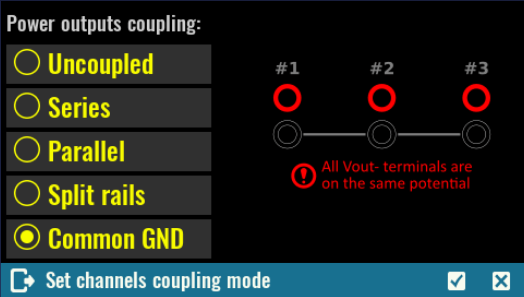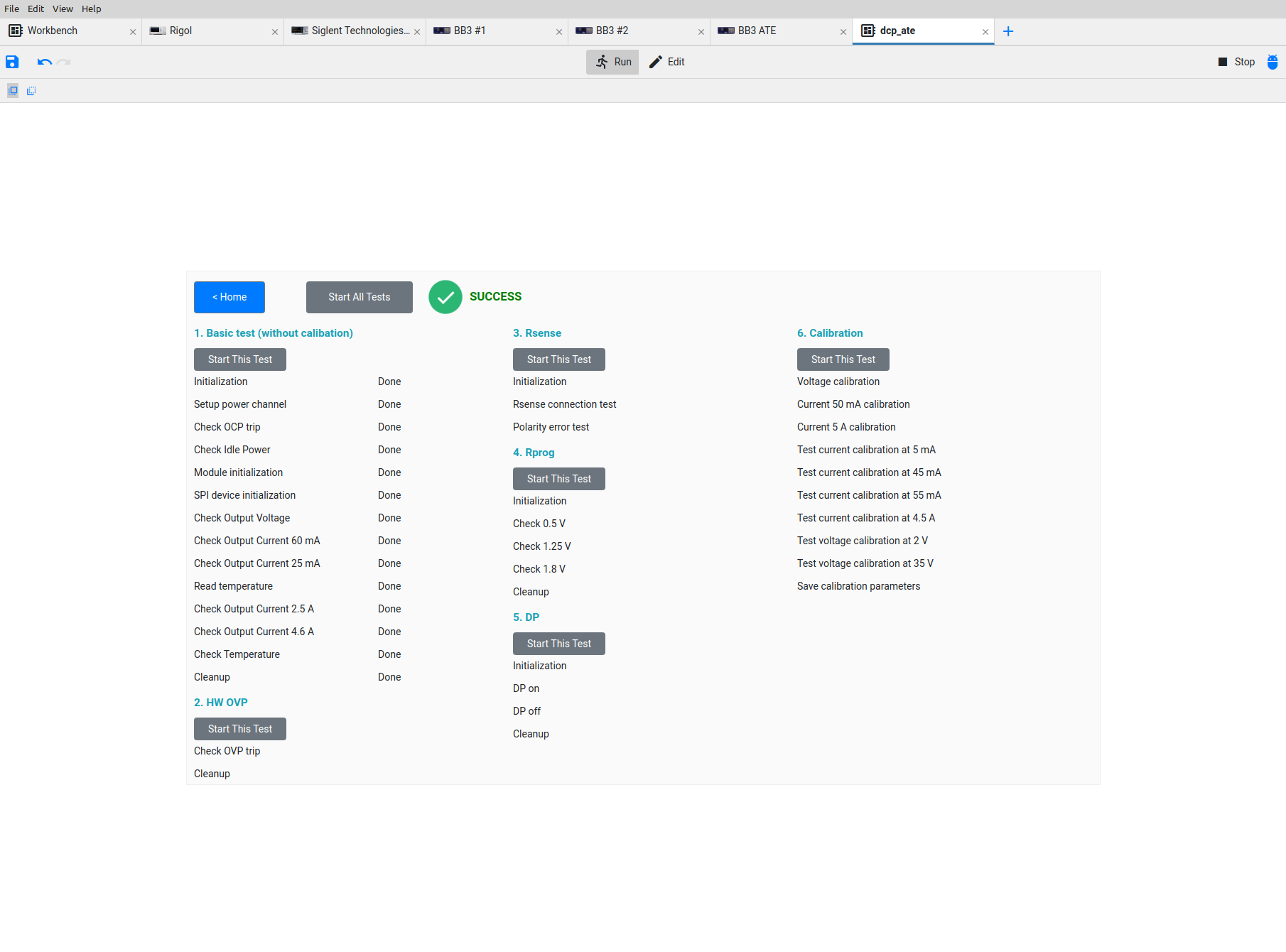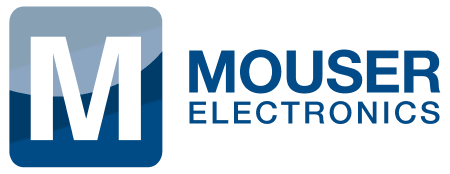
EEZ BB3 (Bench Box 3)
The EEZ BB3 is based on the well-accepted and proven EEZ H24005 concept by adding greater modularity and going beyond DC power source functionality, thus opening up the possibility of adding new modules for data acquisition, control of multiple digital and analog inputs and outputs, etc.
It is compact, expandable, hackable and easy to service, packed with a large number of features that can be selected via a responsive GUI on the color touchscreen. Supported interfaces, technologies, and programmability allow it to be easily and quickly integrated into a variety of environments from one’s benchtop, to a classroom, or production line testing.
Quick Facts
- Modular design based on EEZ DIB – use up to three modules in any combination
- 4.3” color touchscreen display with customizable and responsive GUI
- MicroPython scripting, Node-RED integration, EEZ Flow
- MQTT support
- DC power source up to 6 channels, max. 465 W
- Easily programmable with 400+ SCPI commands
- Built-in Ethernet, USB and UART for remote control
- Build-in removable 8 GiB micro SD card for data logging and programming
- Fast boot, FreeRTOS firmware
- Quiet operation thanks to multi-sensor fan speed control
- Software simulator
- Quick and easy upgrade of the DIB module’s firmware
- Easy maintenance, disassembling and repair
- Open source
Typical applications
- Product development and debugging
- Laboratories and educational facilities
- Quality control and assessment
- Automobile electronic circuit testing
- Production automation testing
- Device or circuit characteristic verification and troubleshooting
The EEZ BB3 comes fully packed with features that make it increasingly attractive for a growing number of use cases. Below are some of the most pronounced features that will make daily work more efficient and safer by reducing the number of possible errors. Many details are well polished thanks to quality user feedback and our ability to implement them quickly because all development takes place in our premises.
Various view modes
Five different views are available to satisfy various use cases as well as user preference for numeric or graphic representation of measured output values. YT view (scan and scroll variant) allows simultaneous display of up to two output values per channel with a refresh rate of up to 200 Hz (5 ms) thus providing a very basic oscilloscope functionality – a useful tool for embedded developers who can find out how the firmware works just by monitoring changes in the current or power consumption.

MicroPython Scripting
Thanks to MicroPython scripting it will be possible to add new functionality without intervening in the BB3 firmware and compromising its performance. Because MicroPython scripts run directly on BB3, its autonomy will not be compromised while scripting opens up the possibility of creating a whole range of new applications from tasks to automate the programming of individual peripheral modules, to useful utilities such as various parameter calculators that do not require working with modules at all, but can be useful and at hand. Fully featured GUI for script can be designed in EEZ Studio or scripts can be downloaded from public directory of approved scripts.
MQTT SUPPORT FOR IOT INTEGRATION
MQTT (Message Queuing Telemetry Transport) is a lightweight publish/subscribe messaging protocol designed for M2M (machine to machine) communication. MQTT is fast becoming one of the leading protocols for IoT (internet of things) deployments. Thanks to MQTT support, BB3 can be easily and securely remotely monitored and controlled. Furthermore, BB3 can be integrated into existing IoT infrastructure.

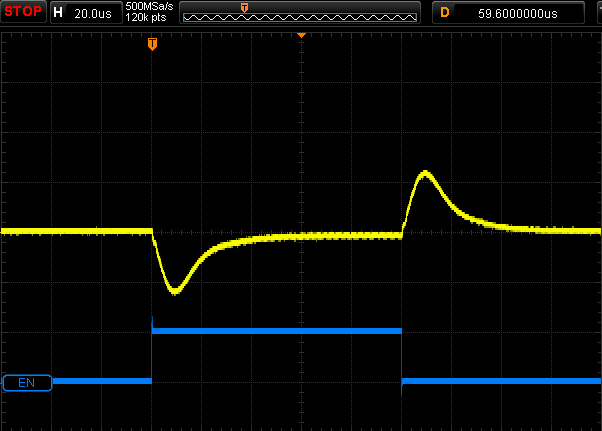
Fast Load Regulation
DCP405 power module offers fast load regulation needed for consumer electronics such as mobile phones and IoT devices require very little power in sleep mode. The increase in current when transmitting can range from a couple of uA to amperes when the voltage drop and overshoot should be as small as possible.
VOLTAGE AND CURRENT RISE TIME CONTROL
Ramp and delay function can be used to reduce inrush current and prevent device damage. Any combination of voltage and current rise time and delay can be configured with on-screen preview.
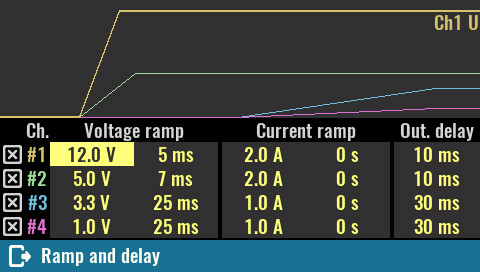
Convenient and Safe Power Outputs Coupling
Because power module outputs are galvanically separated, they can be combined. Coupling provides a safe and convenient way to combine power outputs to increase capacity and offer output configurations. In addition to standard coupling in series or parallel, common ground and split rail coupling has been added for even more flexibility. Four power relays are used to combine the power outputs, avoiding the possibility of poor connections or accidental loss of connection, which could have detrimental effects on the connected load. Coupling can be combined with tracking when two or more channels can be set up simultaneously.
Data Logger
Logging data is key to long-term monitoring either during development or in production. BB3 provides simple data logging of up to 18 output values of installed modules. Logged data is stored on the SD card and can be viewed while the logging is in progress or upon completion or termination of logging. Finally, it will be possible to transfer logged data to a computer using the EEZ Studio application or using similar applications using SCPI commands.


Node-Red Integration for fully open source ATE
The integration with Node-RED allows the creation of complex automation tasks quickly and without the need for common procedural programming. This makes this solution suitable for use in ATE environments for benchtop development, lab testing automation or manufacturing floor quality assurance at reduced costs. An additional advantage of this combination is that it is end-to-end open source and cross-platform which facilitates deployment in different environments and facilitates the sharing of test procedures.
EEZ Flow remote management & automation
EEZ Flow is part of the cross-platform open source low-code EEZ Studio and enables quick and easy creation of flow diagrams and dashboards using ready-made components or external ones that you can create yourself. Execution of EEZ flow can be on a PC which allows simultaneous remote control of multiple BB3 or T&M equipment from other manufacturers. It is an attractive open-source alternative to common ATE applications (MATLAB®, Keysight® VEE, NI LabVIEW™ or programming in Python, C/C++, etc.).
|
Feature |
Benefit |
|
High resolution TFT color touchscreen display for straightforward operation |
Simplifies and speed up setup and operation. The large touchscreen enables faster setup time, thanks to quick navigation through the menus to access all functions and settings. The home page gives a clear overview of all installed modules. Each channel can be selected for a more detailed view with a wide variety of additional information. |
|
Mix and match multiple modules |
Identical or different modules can be quickly installed in any combination on a "plug and play" basis to address different user cases. The unified user interface provides a steep learning curve. |
|
On-module EEPROM |
Module specific information such as activity counters, calibration data, etc. are stored in the EEPROM of the module and remain preserved regardless of whether the module is moved within the same or another chassis. |
|
Simple firmware upgrade |
Upgrading BB3 firmware and firmware on modules with up to date versions is a painless and quick operation that can be done in a few simple steps. |
|
Color themes, customizable module colors and labels |
Setting the module colors according to user preferences increases readability and reduces usage errors. User-defined labels instead of generic ones further help reduce misinterpretations and simplify use. |
|
Power control and fast boot |
The AC mains inputs of power module is under firmware control so that it is possible to turn it on and off remotely (i.e. using MQTT from the other side of the world). Implemented soft-start limits in-rush current to reduce stress on AC mains. A fast boot makes BB3 ready for action in within three seconds. |
|
All channels are independently controlled |
Supports powering up a circuit with multiple voltage levels (such as a digital circuit) that must be turned on in a specified time sequence. |
|
On-screen keypad or rotary knob with step definition for entering numerical values |
Simplifies fast, precise entry of output values. |
|
User profiles to store frequently used configurations in any of 10 setup memory locations |
Saves times when repeating tests. |
|
Programmable sequences (lists) |
Arbitrary waveforms can be generated for voltage and current. Function can be configured and executed locally or remotely. Low jitter of generated sequence allows generating of precise multi-pattern waveforms. |
|
Digital I/Os on the front panel |
Conveniently located are easily accessible that can be connected to an external device that can generate a trigger event, or device under test can interact directly with BB3 by sending SCPI commands and changing its parameters via a simple UART interface, thus improving the automation of the entire process. Additionally the DOUT2 output can be configured as a square wave generator. |
|
NTP |
Support for NTP (Network Time Protocol) ensures that BB3 uses the most accurate time in measurements and activity recordings. |
|
USB OTG mode |
The USB port supports OTG (On-The-Go), so in addition to device mode, it can also be in host mode for connecting a USB mouse or similar peripherals. |
|
Removable micro SD card |
With card capacity of 8 GiB it is possible to store hundreds of hours of data logging, an almost unlimited number of MicroPython scripts, screenshots, programmable lists and activity logs. The card can be replaced with a larger capacity as needed. The data can be accessed directly via a PC or the card can be detached so that the data can be accessed using an external card reader. |
|
Protection functions: OVP, OCP, OTP, OPP |
If set limit for output voltage, current, temperature or power is reached, the affected output channel will be automatically switched off and a message will be displayed. In case when additional safety is needed it is possible to deactivate all outputs or even put a whole chassis in standby mode. |
|
Speed controlled cooling fan |
The noisy environment is tiring and annoying in the long run, so to stay as quiet as possible the BB3 uses a fan with linear speed control defined by a temperature measured at multiple points. |
|
Power outputs coupling |
Allows fast and safe connection of power outputs without additional external wiring for voltage doubling (serial coupling) or current doubling (coupling in parallel). Additionally, it is possible to configure "split rail" power outputs as well as setting common ground between outputs that are otherwise separated (floating). |
|
DCP405: remote programming (modulation input) |
Allows that programmed voltage follows external analog signal that come from connected device or other module or external instrument. |
|
DCP405: remote sensing |
Ensures that programmed voltage is accurately applied to the load. |
|
DCP405: Down-programmer |
Allows discharging voltage quickly even in case with connected device with large input capacitance. |
|
DCP405: Small and power efficient power modules |
Combination of switching pre-regulator and additional linear control reduces size and increases power efficiency delivering up to 155 W. |
|
Software simulator |
The software simulator is a useful tool that we use in our own development because it shortens the prototyping time and is available to anyone who needs to speed up the development of their own modules for BB3. Furthermore, it also offers an attractive alternative to the classic “try before buy” process without the need to negotiate evaluation terms and waiting for a physical sample to arrive. |
|
Open software and hardware design |
BB3 is a certified open hardware design. Openness offers multiple and long-term benefits and preservation of investment: design can be checked in the presale evaluation process, complete freedom in case of servicing, modification and upgrades as well as reducing long-term risk associated with original manufacturer availability. The community gathered around BB3 can shorten the learning curve, allow the exchange of user experiences, can act as technical support, etc. |
- STM32F769 32-bit ARM Cortex®-M7 MCU, 216 MHz, 2 MiB Flash, 512 KiB SRAM
- Digital I/O: 2 x buffered inputs and 2 x buffered outputs (alternative functions: UART, PWM out)
- Rotary encoder with switch
- 1 x user switch
- 3 x dedicated SPI channels (2 x Chip selects per channel), 40-pin IDC connector (DIB v1.0)
- Battery backup (CR2032 button cell type)
- USB FS OTG
- Ethernet PHY (10/100 Mbit/s)
- 32 KiB I2C system EEPROM
- 8 MiB SDRAM
- 8 GiB Micro SD card
- 4.3” TFT color resistive touchscreen display with brightness control
- SWG/JTAG connector (optional)
- Small on-board speaker
- Four power relays for various power outputs coupling
- Full range autoswitch AC input (115 / 230 Vac)
- AC Soft-start (In-rush current limitation) and stand-by
- AC IEC C14 inlet with two 20 x 5 mm fuse
- AC power switch
- AC power input protection and EMI filter
- Standby LED indicator
- Ø80 mm DC cooling fan with speed control
- Kensington lock slot™
- Compact size: 290 (W) x 123 (H) x 240 (D) mm
- Weight (populated with 2 x DCP405 and 1 x DCM224): 4.05 kg
- Remotely controlled by 400+ SCPI commands using the EEZ Studio of similar SCPI controllers, MQTT, Node-RED, etc.
- EMC compliance (not applicable to kit version): EN61326-1:2013, EN IEC 61000-3-2:2019, EN 61000-3-3:2013+A1:2019
- LVD compliance (not applicable to kit version): EN 61010-1:2010, EN 62311:2008
Base modules descriptions
- EEZ BB3 BP3C DIB 3-slot backplane
- EEZ BB3 AUX-PS module with fan controller and AC softstart/standby
- EEZ MCU STM32F7 module
Firmware and MicroPython scripts
Firmware images
System (master) and module firmware download procedures are described in BB3 User manual, Chapter 13.
|
Project |
Type |
Source |
Firmware image (download .hex or .dfu file) |
|
|
System |
 |
|||
|
Module |
 |
|||
|
Module |
 |
|||
|
Module |

|
|||
|
Module |
dib-prel6-fw |

|
||
|
Module |
dib-mio168-fw |

|
||
|
Module |
dib-mux14d-fw |

|
||
Note that the DCP405 module unlike other modules does not have an on-board MCU so it does not require its own firmware.
MicroPython scripts
Consult BB3 User manual, Chapter 16 for scripting with MicroPython.
|
Script name |
Type |
File location |
|
Module initialization |
Python script |
|
|
Resource file |
||
|
Curve tracer |
Python script |
|
|
Resource file |
||
|
Diode tester |
Python script |
|
|
Resource file |
||
|
Op-Amp Calculator |
Python script |
|
|
Resource file |
||
|
Parallel and Series Calculator |
Python script |
|
|
Resource file |
||
|
Voltage Divider Calculator |
Python script |
|
|
Resource file |
What others are saying about BB3
Discord Discussion
Discussion about BB3, new prototypes, use cases, ideas on how to improve the hardware and software part. This is the right place where you can ask us anything. Everyone is invited.
EEVBlog forum
The EEVblog is the world’s biggest engineering blog. An off-the-cuff video blog for Electronics Engineers, hobbyists, hackers and makers. A lot of details about the history of the BB3 project can be found here.
Videos
Short videos about the important features of EEZ Studio and BB3 and how to use them.
Project repository
All project data on BB3 hardware (schematics, BOMs, PCB layouts, mechanical design) and firmware source code are available on GitHub.
Where to buy?
EEZ BB3 in kit version that is successfully crowdfunded on Crowd Supply is available at:
Easy to follow building instructions are available here.















